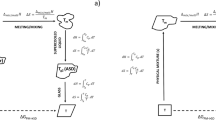Abstract
Purpose. The aim of this study was to clarify the quantitativerelationship between solubility, initial dissolution rate and heat of solution ofracemic compound and its enantiomers.
Methods. Propranolol, propranolol HCl, tyrosine, and tryptophan wereused as typical chiral drugs. The heat of solution of chiral drug wasmeasured by an isothermal microcalorimeter and the heat of fusionwas measured by a DSC. The free energy difference for the dissolutionof drug was calculated from the solubility and initial dissolution ratedata.
Results. The free energy difference and enthalpy difference of thedissolution between the racemic compound and enantiomer ofpropranolol, propranolol hydrochloride, tyrosine, and tryptophan were obtainedby the solubility, initial dissolution rate and heat of solution data. Agood linearity was observed in the free energy difference and theenthalpy difference for the dissolution of them, except for propranololHCl data. By considering the dissociation in solution, the data ofpropranolol HCl followed the regression line.
Conclusions. The free energy difference of the dissolution was linearlydependent on the enthalpy difference for the racemic compound andits enantiomers. The results fit the theoretical equation. It could bepossible to estimate the solubility of chiral insoluble drug from thethermal data.
Similar content being viewed by others
REFERENCES
S. P. Duddu and D. J. Grant. Formation of the racemic compound of ephedrine base from a physical mixture of its enantiomers in the solid, liquid, solution, or vapor state. Pharm. Res. 9:1083–1091 (1992).
L. Wearly, B. Antonacci, A. Cacciapuoti, S. Assenza, I. Chaudry, C. Eckhart, N. Levine, D. Loebenberg, C. Norris, R. Parmegiani, J. Sequeira, and T. Y.-Tomaine. Relationship among physicochemical properties, skin permeability, and topical activity of the racemic compoound and pure enatiomers of a new antifungal. Pharm. Res. 10:136–140 (1992).
H. Takahashi, R. Tamura, T. Ushio, Y. Nakajima, and K. Hirotsu. Ideal enantiometric resolution (preferential enrichment) by recrystallization of a racemic compound V: relationship between preferential enrichment and crystal structures. Chirality 10:705–710 (1998).
R. Tamura, H. Takahashi, T. Ushio, Y. Nakajima, K. Hirotsu, and F. Toda. Ideal enantiometric resolution (preferential enrichment) by recrystallization of a racemic compound. Part 6: Hydrogen bonding mode in the crystal structure. Enantiomer 3:149–157 (1998).
H. Takahashi, R. Tamura, T. Ushio, T. Nakai, K. Hirotsu, and F. Toda. Preferential enrichment: mode of polymorphic transformation of a mixed crystal into a racemic compound crystal. Mol. Cryst. Liq. Cryst. Sci. Technol., Sect. A 313:211–216 (1998).
R. Tamura, H. Takahashi, K. Hirotsu, Y. Nakajima, T. Ushio, and F. Toda. Unusual disordered crystal structure of a racemate exhibiting a novel enantimeric resolution: preferential enrichment. Angew. Chem., Int. Ed. 37:2876–2878 (1998).
M. Elsabee and R. J. Prankerd. Solid-state properties of drugs. III. Differential scanning calorimetry of chiral drug mixtures existing as racemic solid solutions, racemic mixtures or racemic compounds. Int. J. Pharm. 86:221–230 (1992).
S. Takagi and R. Fujishiro. Heats of mixing of optical isomers in solution: Calorimetric evidence of stereospecific effect. Chem. Commun. 480 (1968).
M. Pudipeddi, T. D. Sokoloski, S. P. Duddu, and J. T. Carstensen. Calorimetric determination of the heat of precipitation of pseudoephedrine racemic compound · Its agreement with the heat of solution. J. Pharm. Sci. 84:1236–1239 (1995).
E. Fukuoka, M. Makita, S. Yamamura, and Y. Yoshihashi. Use of microcalorimetry in the field of pharmaceutical sciences. I. Measurement of drug dissolution from solid dosage forms. Chem. Pharm. Bull. 42:2139–2142 (1994).
S. Prakongpan, W. I. Higuchi, K. H. Kwan, and A. M. Molokhia. Dissolution rate studies of cholesterol monohydrate in bile acid · lecithin solution using the rotating-disk method. J. Pharm. Sci. 65:685–689 (1976).
H. Nogami, T. Nagai, and A. Suzuki. Studies on powdered preparations. XVII. Dissolution rate of sulfonamides by rotating disk method. Chem. Pharm. Bull. 14:329–338 (1966).
D. Q. M. Craig and J. M. Newton, Characterisation of polyethylene glycols using solution microcalorimetry. Int. J. Pharm. 74:43–48 (1991).
Author information
Authors and Affiliations
Rights and permissions
About this article
Cite this article
Yonemochi, E., Yoshihashi, Y. & Terada, K. Quantitative Relationship Between Solubility, Initial Dissolution Rate and Heat of Solution of Chiral Drugs. Pharm Res 17, 90–93 (2000). https://doi.org/10.1023/A:1007578811049
Issue Date:
DOI: https://doi.org/10.1023/A:1007578811049




